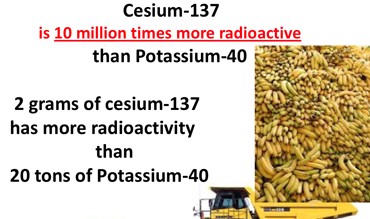– Alaska refuses to test radiation levels in fish, says banana is riskier…”and who doesn’t love bananas?” — Officials: It’s forecast to hit U.S. right about now; People are concerned; We absolutely need cautious monitoring (ENENews, Jan 23, 2014):
Juneau Empire, Jan. 23, 2014: The Department of Environmental Conservation isn’t actively testing fish for radiation, Commissioner Larry Hartig told the Senate […] Hartig said the state is relying on data and analyses from other coastal states, British Columbia and federal agencies […] Still, Sen. Cathy Giessel, R-Anchorage, said her constituents have come to her with concerns. Hartig said in an interview that the department tests fish regularly, just not for radiation. […] Hartig said it would be too expensive for the state to undertake a testing program that would be “statistically valid.” […] he’s concerned that people are being misinformed […]
Cesium-137 emits 10 million times more radiation per unit volume than does potassium-40 found in a banana. (SOURCE: Steven Starr, Director of the Clinical Laboratory Science Program at the University of Missouri)Jonathan Kreiss-Tomkins, Alaska House of Representatives (Sitka), Alaska Dispatch, Jan 22, 2014: […] Fukushima radiation is a classic example for which the solution to pollution is in fact dilution. The vast Pacific Ocean is diluting Cesium-137 radioactivity by nearly 200 percent by the time the Kuroshio Current carries Fukushima water to our side of the Pacific. Water contaminated by the Fukushima Daiichi Nuclear Plant is forecast to arrive on the West Coast, well … right about now. Computer models predict that Fukushima-contaminated water washing up on the West Coast has between 1 Bq/m3 and 30 Bq/m3 of Cesium-137. (Remember, 7,400 Bq/m3 is the EPA limit, and 2 Bq/m3 is the naturally occurring level.) Early data gathered up and down the West Coast corroborates these predictions. […] To be clear: there may well be more radiation in a banana (and who doesn’t love bananas?) than off our Alaska coast. […] But we absolutely need to cautiously monitor the situation. There are legitimate reasons to be concerned about Fukushima, and the Department of Environmental Conservation should play a visible, proactive leadership role. It has not. […]
Fairbanks Daily News-Miner, Jan. 23, 2014: […] Hartig said the state has not seen concerning radiation levels […] and has no plans to launch its own radiation monitoring […] “you get more radiation risk from eating a banana” [He] said that monitoring in the Lower 48 and by the federal government have not shown there to be radiation meeting dangerous levels […] Radiation from the disaster has been a lasting concern for many, including Interior residents. People have worried that water-based and airborne radiation will contaminate food sources and pose a health risk to people. University of Alaska Fairbanks researcher Douglas Dasher [said] modeling that showed radioactive cesium-137 would begin hitting Alaska soon, although he said researchers said it is still many times smaller than accepted federal guidelines. Dasher did, however, point out a concern about the lack of research and monitoring being done in Alaska.
